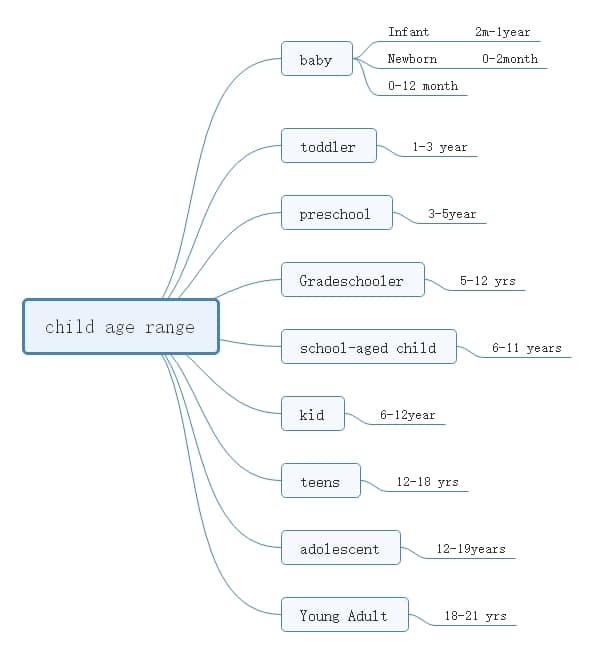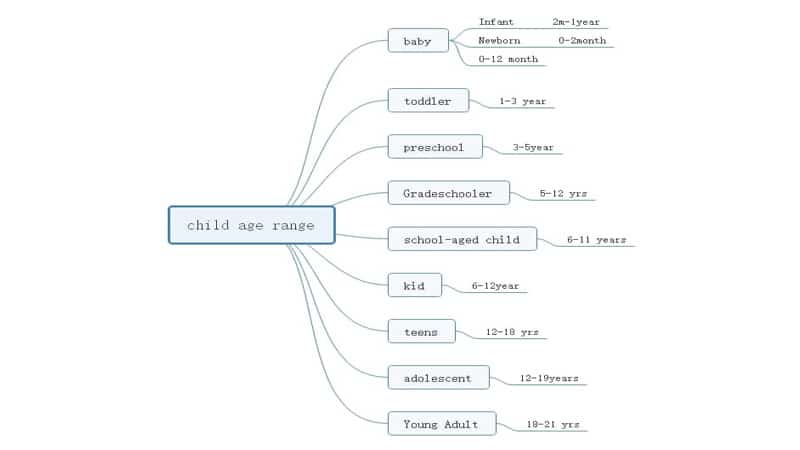Just check following image to show all of age ranges:

So you wish to know the age difference between a baby, newborn, infant, toddler, kids, and preschool child! Perhaps, you’re expecting a child and want to treat him/her according to his/her age. Maybe, you’re confused about various opinions on the ages of a small child. No matter the reason, keeping yourself informed is a better bet. As well as avoiding confusion, it’ll let you prepare for your child accordingly.
Contents
What’s the age difference between a baby, newborn, infant, toddler, kids, and preschool child?
The English language includes various terms for small children aged from birth to 4 years. Often the terms are used interchangeably. However, those terms may mean different things to each individual. Some people call small children babies even if their children cross 4 years of age. On the flip side, some parents call them kiddies or toddlers.
You may wonder what if you call a kid a baby. As a parent, you may even call your teenage a baby. So, what would you benefit by categorizing the child into particular terms based on his age? Well, small children need to be monitored, nurtured, and administered suitable nourishment and medicines from time to time.
When you visit a supermarket, you’ll find items labeled as “for toddlers” or “for infants”. Knowing the right terms will let you choose the right nourishment and medicines. Also, keeping informed will let you take appropriate steps for your child’s growth and development.
Newborn age range
The term newborn actually refers to a newly born baby. According to doctors and experts, a newborn age range is a baby aged between 0 and 2 months. The World Health Organization defines a newborn as a baby that’s less than a month. During the first two months, appropriate feeding and care are essential to enhance the child’s likelihood of survival as well as to lay a foundation for his healthy life.
Growth and development
When a baby is just born, he usually cries to signal needs. Ideally, the newborn will cry when he feels uncomfortable or hungry. He may also cry to draw your attention toward his pain or other ailments. As a parent, it’s your duty to respond to those signals and ensure you meet his needs.
As the nervous system gets matured, the child becomes capable of using his thoughts into actions. Soon the newborn will use subtle actions to communicate and interact with you. You may notice bodily gestures during this period. The newborn will seek communication and express his feelings with sounds and facial gestures.
During this stage, newborns listen to and try to absorb the basic, distinct language sounds. This process serves as the basis for speech. Attachments to parents and primary caregivers are normal during this phase. Your child hears well and responds to loud, high-pitched sounds after some days.
His vision develops quickly, but it’s weak. Newborns entertain and control their movements through reflexes by exploring their toes and fingers. They also develop bonds of trust and love with their parents and caregivers as a part of social and emotional development. The way you cuddle, hold, and play with your newborns will form the foundation for how they’ll associate with you and others.
Infant age range
The term baby, infant, and newborn are often used synonymously. However, there’s a difference between these terms. As stated earlier, a newborn is a baby aged between 0 and 2 months. On the other hand, an infant age range is a baby between 0 and 12 months.
During the first six months, exclusive breastfeeding is highly recommended. Crying and fussing are the primary types of communication. Infants react to touch, turn toward a voice, and seek out the bottle or his mother’s breast.
Growth and development
During the infancy phase, babies develop an exclusive bond with their caregivers and parents. They learn to clap, smile, wave, babble, pick up objects, and crawl. Some babies may even start talking using a few rods. At the age of around 6 months, infants are in a position to roll over and sit properly without any kind of support.
In this stage, infants learn various things such as focusing their vision, reaching out, exploring things around them, and a lot besides. By the end of the year, some infants even learn to walk. However, a majority of them use some support for walking slowly. Additionally, they recognize objects and understand simple commands
Toward the end of the year, a child gains weight substantially. Ideally, an infant triples his birth weight and add around 6 to 8 inches to his height. Once the infant reaches his first year of age, he becomes a toddler.
Toddler age range
A toddler is a child between the age range of 1 and 3 years. Some people consider their child a toddler till he’s ready for his preschool. However, the preschool age begins after the toddling age. During the toddling stage, the child becomes more mobile and independent. Also, he learns to express numerous emotions, speaks in sentences and phrases, and understands how to get dressed.
Growth and development
Various changes take place during the toddling phase. A toddler starts uttering a few words such as dad, mum, and more. Additionally, he responds to sounds and understands the connection between objects and names. A toddler’s height increases by 50 percent over his birth height. Similarly, he gains enough weight and strength to walk easily.
When the child reaches 2 years of age, he tries to walk around and moves here and there. Toddlers love songs, rhymes, and simple games. They start learning alphabets, shapes, colors, and other things. They absorb very quickly and memorize whatever they hear and understand. An average toddler reaches about half his adult height by the time he becomes 3 years old.
Baby age range
The term baby is used to refer to a child from birth to 4 years of age. Newborns, infants as well as toddlers can be called babies. In a nutshell, a young offspring is referred to as a baby.
A newly born child is a baby. Also, a young one is a baby regardless of his age. Babies who’re spoken to and responded during their first few years learn skills, languages quickly than other babies.
Growth and development
The development and growth of babies cover all the aspects of newborns, infants, and toddlers. That means anything the child learns from his birth to the toddling age. Similarly, nourishment and care encompass the varied aspects from the newborn age to the toddling age.
A baby stage is considered to be a crucial phase and categorized accordingly. It’s the first 4 years of the child that paves the path for schooling. After learning a few basic skills such as talking, walking, and some manners, the child is ready to go to a school.
Preschool age range
The preschool age range starts at 3 and ends at 5. During this stage, the child learns to talk fluently. Ideally, parents enroll their preschool children in kindergarten. It’s here the child gets his first company of buddies.
Growth and development
During the preschool age, a child asks too many questions frequently. As a parent, you should answer all questions to his fullest satisfaction. If you ignore or scold your child for asking questions, he won’t learn and develop.
Some children use bad words if they’ve heard them repeatedly. It’s important to check what the child speaks and how he behaves. Any mistakes should be corrected for his betterment. In addition to speaking, the child learns to sharpen his grasping skills as he gets ready for his school tenure.
Kids age range
Once the child passes a kindergarten and enters the first or second standard of his school, he reaches the age of 6. During this age, the child becomes a kid. The age of a kid lasts from 6 to 12 before he becomes a teenager. Many people even call a preschool child a kid. That doesn’t make much difference in his day to day life. However, an ideal kid’s age begins from 6.
Growth and development
A kid is a lot sharper than a preschool child. The kid age is supposed to be one of the two best phases of a child. A child learns more during his teenage and kid age. To prepare for his teenage and subsequent adulthood, a child needs to develop well during his kid age.
A kid enjoys various activities and stays busy. He loses his first tooth, and his sense of wisdom starts developing. A kid likes to do painting and ride a bike. By the time he reaches the age of 12, he gains more graceful with abilities and movements.
Summary
A newborn is a baby under two months, whereas an infant is a child less than 1 year. On the other hand, a toddler ages between 1 and 3 years, and a preschool ages between 3 and 5. Any child between 0 and 4 years can be called a baby. A kid is a child who enters a school, and his age lies between 6 to 12 years. Understanding these differences help parents to take suitable actions toward the growth, development of their small children.

